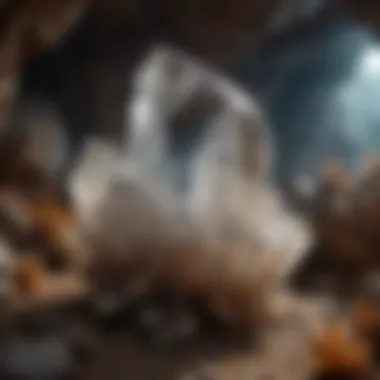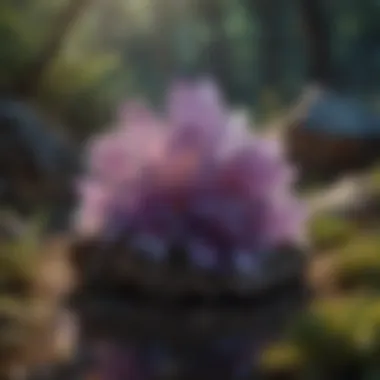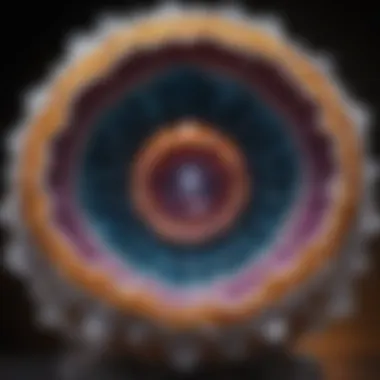Unveiling the Enchanting Universe of Natural Crystals


Rock and Fossil Identification
Crystals in nature exhibit a spectacular array of formations, each with its distinctive characteristics and significance. Understanding the types of crystals found in various environments is crucial for rock and fossil collectors looking to expand their knowledge base. Differentiating between crystal structures requires a keen eye for detail, as well as an understanding of the geological processes that influence their formation. Advanced tools, such as polarizing microscopes and chemical tests, are indispensable for accurate identification.
Geological Insights
Geological formations play a pivotal role in the creation of crystals, with specific environments conducive to the development of unique crystal types. From igneous to sedimentary rocks, the geological processes that occur over millennia contribute to the formation of crystals with distinct properties. Exploring the historical significance of these crystals sheds light on the evolution of Earth's terrain and the noteworthy discoveries made by geologists and collectors. Notable findings in the field continue to enhance our understanding of crystal formations and their relevance in geology.
Introduction to Crystals
In this article, we delve deep into the mesmerizing realm of crystals in nature, offering a comprehensive guide to understanding their formation, properties, and significance. Our exploration begins by highlighting the intricate processes that give rise to these exquisite structures and delves into the diverse types of crystals found in various environments. By unraveling the mysteries of crystal formations, we aim to captivate and educate rock and fossil collectors with a deep appreciation for the beauty and complexity of crystals.
Definition and Characteristics of Crystals
The Molecular Structure of Crystals
The molecular structure of crystals plays a pivotal role in determining their unique properties and formations. With a defined and orderly arrangement of atoms, crystals exhibit a uniformity and symmetry that sets them apart from other materials. This structural organization contributes to the clarity, hardness, and refractive nature of crystals, making them highly desirable for various scientific, industrial, and aesthetic applications. Understanding the molecular structure of crystals is fundamental to appreciating their beauty and functionality within the natural world.
The Symmetry and Geometry of Crystal Formations
The symmetry and geometry of crystal formations are key aspects that influence their overall shape and growth patterns. Crystals exhibit precise geometric arrangements due to their inherent molecular structure, leading to the formation of symmetrically aligned faces and angles. This geometric uniformity reflects the internal order of crystals and highlights their intricate beauty. By studying the symmetry and geometry of crystal formations, we gain a deeper insight into the underlying principles that govern their growth and development.
Unique Properties of Crystals
Crystals boast a myriad of unique properties that set them apart from other materials in nature. From their ability to transmit, reflect, and refract light to their piezoelectric and pyroelectric properties, crystals showcase a diverse range of characteristics that make them valuable in various industries and applications. The alignment of atoms within crystals contributes to their optical clarity, hardness, and energy-transmitting capabilities, making them indispensable in technology, healing practices, and artistic endeavors. Exploring the unique properties of crystals allows us to unlock their full potential and appreciate the holistic impact they have on our lives.
Importance of Crystals in Nature
Role of Crystals in Geological Processes


Crystals play a crucial role in geological processes by forming through a series of natural phenomena that occur over vast time scales. From the crystallization of minerals in magma chambers to the metamorphic transformations deep within the Earth's crust, crystals provide valuable insights into the history and composition of our planet. By studying the role of crystals in geological processes, geologists and scientists can unravel the intricate mechanisms that shape the Earth's surface and subsurface, paving the way for groundbreaking discoveries and advancements in earth sciences.
Impact of Crystals on the Environment
The presence of crystals in the environment influences various ecological processes and phenomena, ranging from mineral weathering to nutrient cycling in ecosystems. Crystals act as natural indicators of environmental conditions and geological events, reflecting changes in temperature, pressure, and chemical composition. Their interactions with plants, animals, and microorganisms play a significant role in shaping local habitats and landscapes. Understanding the impact of crystals on the environment sheds light on the interconnectedness of natural systems and underscores the importance of preserving ecological balance for future generations.
Significance of Crystals in Various Ecosystems
Crystals hold significant value in different ecosystems, serving as essential components of soil composition, rock formations, and mineral deposits. Their presence influences the fertility of soils, the stability of geological structures, and the availability of resources for various organisms. From crystal-rich cave systems to mineral-rich oceanic depths, ecosystems around the world rely on crystals for sustenance and ecological resilience. Recognizing the significance of crystals in various ecosystems underscores their integral role in supporting life forms and maintaining planetary equilibrium.
Historical Significance of Crystals
Ancient Civilizations and Their Use of Crystals
Ancient civilizations have long revered crystals for their healing, spiritual, and decorative properties, incorporating them into rituals, ceremonies, and everyday life. From the Egyptians' use of lapis lazuli in jewelry to the Aztecs' admiration for quartz crystals, our ancestors valued crystals for their beauty and metaphysical qualities. The historical significance of crystals in ancient cultures underscores their enduring appeal and cultural significance throughout human history.
Spiritual and Cultural Significance of Crystals
Crystals hold a profound spiritual and cultural significance across diverse traditions and belief systems. From the Native American practice of using turquoise for protection to the Buddhist tradition of employing crystal malas for meditation, crystals symbolize purity, energy, and transformation in spiritual contexts. The cultural interpretation of crystals as talismans, amulets, and healing tools reflects a universal connection between humanity and the natural world. Exploring the spiritual and cultural significance of crystals deepens our appreciation for their intrinsic value beyond material worth.
Evolution of Crystal Utilization Over Time
The evolution of crystal utilization spans centuries of human ingenuity and creativity, adapting to technological advancements and cultural shifts. From ancient alchemical practices to modern scientific applications, crystals have transitioned from mystical relics to essential components of our daily lives. The progressive harnessing of crystal energies for healing, communication, and information storage highlights the versatile nature of these mineral treasures. Observing the evolution of crystal utilization over time allows us to trace the transformative journey of crystals from ancient mysteries to contemporary innovations, bridging the gap between tradition and modernity.
Formation of Crystals
Delving into the uncovers a myriad of specific elements that contribute to the magnificence of crystal formations. From the primary methods of crystal formation to the factors influencing crystal growth and the conditions conducive to crystal development, each aspect plays a pivotal role in shaping the unique characteristics of crystals found in nature.
One of the key benefits of delving into the lies in unraveling the mystery behind the remarkable symmetry and geometry of crystal formations. By comprehending the intricate molecular structures that give rise to crystals, enthusiasts and collectors gain a deeper appreciation for the inherent beauty and complexity encapsulated within each crystal.
Moreover, exploring the formation of crystals sheds light on the diverse environments and processes that contribute to the birth of different crystal types. By studying the mechanisms that govern crystal growth and development, enthusiasts develop a heightened awareness of the delicate balance required for crystals to manifest their full splendor.


In this article, the section offers a comprehensive examination of the underlying processes that govern crystal formation, highlighting the significance of each element in shaping the mesmerizing world of crystals in nature. By immersing oneself in the intricate details of crystal formation, readers gain a profound understanding of the awe-inspiring journey undertaken by crystals as they evolve and flourish in diverse natural settings.
Types of Crystals
In the realm of crystals, understanding the various types is crucial to comprehending their intricate beauty and significance in nature. This section delves into the importance of different crystal classifications, shedding light on their structural diversity and unique properties that captivate rock and fossil collectors.
Classification Based on Structure
Cubic Crystals
Exploring the world of cubic crystals unveils a fascinating dimension of geometric precision and symmetry. Cubic crystals, characterized by their equal sides and angles, play a significant role in this article by showcasing a prominent structure that defines various crystal formations. Their distinctive symmetry not only makes them visually appealing but also enhances their usability in different applications. Despite their conventional nature, cubic crystals remain a popular choice for crystal enthusiasts due to their easily identifiable shape and the way they interact with light, emphasizing their brilliance in mineral collections.
Hexagonal Crystals
The realm of hexagonal crystals introduces a dynamic aspect to the spectrum of crystal structures, emphasizing the significance of their six-sided symmetry. Hexagonal crystals contribute uniquely to the overarching theme of crystal diversity in this article, showcasing a shape that reflects nature's intricate patterns. Their key characteristic lies in the interconnectedness of their sides, creating a mesmerizing visual allure that appeals to collectors seeking a blend of elegance and complexity. While hexagonal crystals present certain challenges in terms of handling and storage due to their specific shape, their aesthetic appeal and natural allure make them a favored choice for enthusiasts interested in exploring the vast array of crystal forms.
Orthorhombic Crystals
Orthorhombic crystals add a layer of complexity and depth to the narrative of crystal structures, highlighting the importance of their unique arrangement of axes. In the context of this article, orthorhombic crystals bring forth a dimension of crystallography that showcases distinctive characteristics essential in understanding crystal formation and behavior. Their key feature lies in the unequal parameters of their axes, contributing to a diverse array of crystal habits and formations. While orthorhombic crystals may present challenges in certain applications due to their asymmetrical nature, their role in the crystal kingdom underscores the complexity and beauty inherent in natural mineral formations.
Varieties of Crystals
Amorphous Crystals
Amorphous crystals represent a unique category within crystal classifications, offering a departure from the traditional structural patterns observed in crystalline substances. Their contribution to this article lies in providing insight into the unconventional forms that crystals can take, blurring the boundaries between order and randomness in mineral formation. The key characteristic of amorphous crystals lies in their lack of long-range order, presenting a fascinating study in imperfections that contribute to their intriguing visual appeal. While amorphous crystals may not possess the same level of clarity or defined structure as other crystal types, their diversity and unpredictability make them a captivating choice for collectors intrigued by the unconventional beauty of crystal formations.
Organic Crystals
The world of organic crystals introduces a captivating fusion of natural materials and crystalline structures, showcasing the intricate patterns and unique properties inherent in organic substances. Organic crystals play a significant role in this article by highlighting the diversity of crystal origins and compositions, emphasizing the bond between biological processes and mineral formation. Their key characteristic lies in the incorporation of carbon-based compounds, infusing a sense of vitality and connectedness to living organisms within their crystalline frameworks. While organic crystals may present challenges in terms of stability and maintenance, their mesmerizing beauty and ecological resonance make them a sought-after choice for collectors seeking a deeper connection to the natural world.
Inorganic Crystals


Inorganic crystals represent a backbone of mineral formations, setting the stage for understanding the fundamental principles that govern crystal growth and stability. Their contribution to this article underscores the importance of inorganic compounds in shaping the diverse landscapes of crystal diversity. The key characteristic of inorganic crystals lies in their non-carbon-based compositions, emphasizing the elemental purity and stability that define their crystalline structures. While inorganic crystals may exhibit less variability in color and texture compared to organic counterparts, their steadfastness and durability make them a reliable choice for collectors interested in the enduring beauty of mineral specimens.
Preservation and Collection of Crystals
The preservation and collection of crystals play a pivotal role in understanding and appreciating the intricate beauty of these natural wonders. Not only does proper preservation techniques ensure the longevity of crystal specimens, but it also allows for future generations to marvel at their splendor. In this article, we delve into the specific elements that make the preservation and collection of crystals indispensable to enthusiasts and researchers alike.
Methods for Preserving Crystals
Storage techniques for crystal specimens
Storage techniques for crystal specimens are crucial in maintaining the integrity and quality of these delicate formations. Proper storage not only prevents physical damage from external factors but also protects crystals from potential chemical reactions that can alter their composition. By storing crystals in a cool, dark, and dry place, collectors can safeguard their specimens for years to come. The key characteristic of storage techniques lies in their ability to prolong the longevity of crystals, making them a popular choice for preserving these natural treasures. Despite their advantages, some storage techniques may require specific environmental conditions, which can be a limitation for collectors in certain regions.
Precautions to prevent crystal damage
Taking precautions to prevent crystal damage is essential in ensuring the preservation of crystal collections. By handling crystals with care and using protective measures such as padding and secure casing, collectors can minimize the risk of scratches, chips, or fractures. The key characteristic of these precautions is their ability to safeguard the physical integrity of crystals, maintaining their aesthetic appeal and value. While these measures are beneficial for protecting crystals, they may be time-consuming and require diligence to implement consistently.
Cleaning and maintaining crystal collections
Cleaning and maintaining crystal collections is a meticulous process that involves gentle techniques to remove dust, dirt, or residues without harming the crystals. Regular cleaning not only enhances the visual appeal of specimens but also prevents deterioration caused by environmental contaminants. The unique feature of cleaning and maintaining crystal collections is the use of non-abrasive methods such as soft brushes, mild detergents, and distilled water to preserve the natural beauty of crystals. While cleaning is essential for preserving crystals, improper techniques can lead to damage or discoloration, highlighting the importance of thorough research and caution in this aspect of collection care.
Conclusion
In the realm of crystals in nature, the Conclusion section serves as a pivotal point where the intricate facets and profound implications of crystal wonders culminate. Highlighting the key points discussed throughout this article, the Conclusion encapsulates the essence of crystal formations and their multifaceted significance. By synthesizing the information presented, readers gain a holistic view of the mesmerizing world of crystals.
Final Thoughts on Crystal Wonders
Appreciating the beauty of crystal formations
Delving into the realm of crystal wonders, appreciating the beauty of crystal formations unveils a mesmerizing aspect that captivates enthusiasts. The intricate structures and mesmerizing hues of crystals contribute remarkably to the allure of these natural marvels. The kaleidoscopic play of light within crystal formations not only mesmerizes observers but also provides a sense of tranquility and aesthetic pleasure. Appreciating the beauty of crystal formations is a cornerstone in understanding the artistic grandeur embedded in nature, making it a popular choice for exploration within the realms of this article. Despite its unquestionable beauty, the fragility of crystal formations necessitates careful handling to preserve their splendor effectively.
Recognizing the diversity and complexity of crystals
Among the myriad facets of crystal wonders lies the importance of recognizing their diversity and complexity. Crystals exhibit a vast array of structures, compositions, and properties, showcasing the richness of nature's creations. Understanding the diverse forms and intricate compositions of crystals enhances one's appreciation for their multifaceted nature. By recognizing the complexity of crystals, enthusiasts are drawn into a realm where each specimen tells a unique geological tale. The diversity in crystal formations not only enriches collectors' experiences but also underscores the boundless beauty and complexity of natural processes. However, with this diversity comes the challenge of accurate identification and classification, adding a layer of intricacy to the exploration of crystals.
Continuing the exploration of crystals in nature
The journey into the enchanting world of crystals does not conclude with mere observation but beckons towards continuing exploration. Delving deeper into the origins, properties, and formations of crystals unveils a never-ending voyage of discovery and enlightenment. By continuing the exploration of crystals in nature, enthusiasts solidify their understanding of geological processes, crystallography, and mineralogy. This ongoing quest for knowledge not only expands one's expertise but also fosters a profound connection with the earth's natural treasures. The allure of exploring crystals in their natural habitats lies in the potential for groundbreaking discoveries, fostering a sense of awe and curiosity. However, this perpetual exploration demands meticulous research, patience, and a keen eye for detail to unravel the mysteries concealed within crystal formations.







